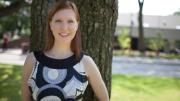A self-described “radical optimist” who’s traveled the world as a dancer and choreographer, Jill Johnson brings both her fiery red hair and warm personality to Harvard as the new Office for the Arts (OFA) dance director. Harvard Magazine recently sat down with Johnson to discuss her transdisciplinary approach to dance, changes she’s ushering in, and her first-ever flash mob creation for the school’s 375th birthday. (Read more of Johnson's thoughts in this article on dance as a creative outlet and form of personal expression from the November-December 2011 issue.)
You're a self-described "radical optimist." Tell me about that.
The act of creating anything—choreography, the design for a building, writing a book—anything where you generate something from nothing, or from a set of ideas, has to have a certain kind of optimism to it, otherwise you wouldn’t even start. Radical optimism means that moments construed as challenges are actually teachable moments; roadblocks shed more insight into the process. Radical optimism also has to do with hope—the hope that you will create something someone is interested in, shed some light onto something, and make someone feel a different way.
You've worked with probably some of the best dancers in the world. None of the Harvard students you work with are dance majors. Does that make it tougher to teach them?
I think there’s a way to pursue studies in dance without formal training, and it actually sometimes allows for more creativity.
What's changed about the dance program since you've taken over?
We’re already showing that we’re invested in the idea of community. We’ve had a number of master classes that we’ve added already to the program activities that have been really exciting. [The dance program regularly hosts guest artists and leading choreographers who teach master classes and hold residencies throughout the academic year.] We’re not just cloistered here doing our own thing, we’re reaching out to our neighbors.
Another big change is the space. I feel strongly about our space supporting student activity. The main hallway going to the studio theater used to be mostly transitional space, and now it is a place where students can meet and have conversations with each other—they are able to work on a thesis statement, or finish an essay. It also promotes more impromptu student-teacher mentor meetings.
This transdisciplinary approach to dance learning is reflected in our spaces. We wanted to create a group of spaces…that aren’t so specific to dance. As well as having dance performance represented, we want the space to also be about architecture, design, science. We have a mobile that has all kinds of quotes from all kinds of thinkers from all kinds of backgrounds; the idea is to think about ideas. Finding the right questions to ask is also very important in dance learning and dance—thinking rather than simply having to have the right answer.
What do you hope Harvard students take away from your classes?
I hope that their idea of what dance is opens up to fold into all the other things that they are engaged in studying. I hope in opening up their thinking about dance it opens up their thinking as a person and a learner—and that they develop a sense of discernment, a design eye.
One of the fascinating things about dance learning is that it uses the body, primarily, to learn things—you can’t separate the mind and the body. It’s the idea that generates the movement, the learning itself comes through the body, and it takes the time it takes. You can’t set your preferences and all of a sudden you’re a great dancer. I think that’s something to be celebrated. I think that’s why there is this great move towards dance, part of it is that need to get back to this thing we can’t change—the body.
Tell me about choreographing the 375 flash mob.
It was the first flash mob I’ve ever choreographed! The main thrust of the 375 dance was that everyone has fun, it shouldn’t be a drag to do, you pick it up by osmosis in the moment. It was designed to be a dance for a family birthday party—accessible, multigenerational, and really, everyone just having fun moving in the space as a community.
When did you start to dance?
I moved around to music a lot as a baby, and I began taking formal lessons when I was four. For me, dance, has always been a vocation. As an educator I feel a great deal of responsibility to keep the field vital and share this incredible art form with as many people as I can.








